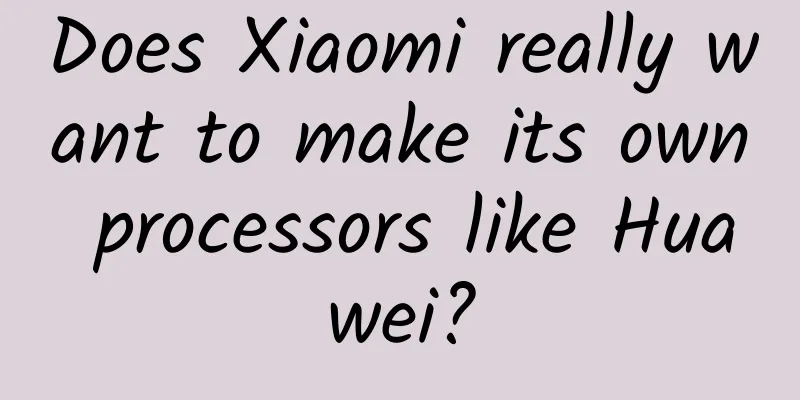Does Xiaomi really want to make its own processors like Huawei?

|
It is not a new concept for mobile phone brands to make chips, as Apple and Samsung have been doing so for a long time. Ever since Huawei launched HiSilicon Kirin 920 this year and adopted self-developed chips in all its mid-to-high-end models and achieved good market response, it seems that other companies' appetites have been whetted. ZTE has already launched its own processors, and Xiaomi has also formed a joint venture with Unigroup. Do mobile phone brand manufacturers really have to develop their own chips? While mainland mobile phone brands have launched or begun to study whether to establish their own processor development teams, Samsung has begun to rectify. In the second half of this year, the head of Samsung's LSI department was replaced. The former head of the wafer foundry department took office as the general manager of the LSI department. The first three things the new official did after taking office were the integrated circuit design teams in the United States, Europe, the United States and mainland China. The three teams were laid off. It is unclear what Samsung's LSI teams in the United States and Europe have done. Samsung's Hangzhou semiconductor department was once the development team of the Galaxy Note and Note 2 application processors. Such an excellent team would probably be treated as a treasure in any company in mainland China, but it's a pity that Samsung laid it off. Why? It should be said that among all mobile phone manufacturers, Apple's processor strategy is the most clear. All new iPhones and even iPads use the same processor. With Apple's annual sales of hundreds of millions of mobile phones, the cost of application processors has been minimized, and Apple's mobile phone configurations are also guaranteed to be unique. No matter how Android phones compete in configuration, Apple always upgrades its products according to its own strategy, doing its own thing and being unique. The benefits of mobile phone manufacturers developing chips are fully reflected in Apple. Although there are rumors that Apple will develop its own baseband chip, Lao Yao believes that the probability should be small, because compared with the application processor, the baseband is much more difficult, especially after the communication technology is upgraded to 4G, more and more frequency bands need to be supported, and the technology is becoming more and more complicated. The necessity for Apple to invest in baseband technology is not high. With the improvement of Intel Infineon's baseband technology, it is rumored that in 2015 Apple will introduce Intel as the second baseband supplier besides Qualcomm. In this case, there is no need for Apple to invest in baseband technology. It is better to invest in sensors and other fields that bring more features to mobile phones. Another brand whose investment in chips has brought huge returns is Huawei. Unlike Apple, which focuses on application processors in the chip field, Huawei HiSilicon focuses on baseband or SOC development. In 2014, Huawei relied on its unique Kirin 920 processor to set off a craze for core technology with independent intellectual property rights. In fact, HiSilicon has been criticized by the industry in the past few years. HiSilicon's investment in baseband can be said to be a decade of hard work, and it was not until last year that it achieved a breakthrough. Baseband technology not only brings core technology to Huawei's mobile phones, but also serves as a bridge between mobile phones and core business network equipment. Therefore, investment in chip development is as important to Huawei as application processors are to Apple. This is also the reason why Ren Zhengfei has given money and people to HiSilicon with all his strength in the past decade. Fortunately, HiSilicon worked hard and finally made a breakthrough in 2014, which received good market response. It is believed that mobile phone chips will become more and more important to Huawei in the future, and chip design will increasingly become one of the core competitiveness of Huawei's mobile phones and network equipment. Looking back at Samsung, although Samsung's baseband technology has not been up to standard, Samsung's investment in application processors in the past few years has brought Samsung good returns. Until the emergence of 4G, it should be said that self-developed application processors have played a great role in promoting the rise of Samsung mobile phones. Even without AMOLED panels, the effect is greater, because with its own application processors, Samsung's high-end models can be ahead of competitors in configuration. However, Samsung does not have the strength of Apple after all, which can make Qualcomm only provide baseband chips. In the past few years, even when Samsung was at its peak, its high-end products did not dare to abandon Qualcomm chips. Moreover, since it does not have its own OS, Samsung has to follow Android's development strategy when using Android. It cannot launch 64-bit processors according to its own plan and achieve technological leadership like Apple. Samsung first launched the Bada operating system and later launched the Tizen OS. They all wanted to get rid of the constraints of Android. The strategy was not wrong, but unfortunately the attempt was not successful. It is said that Samsung's self-developed five-mode 13-band SOC has begun testing in China Mobile, indicating that its baseband technology has gradually caught up, but how to position this SOC is a problem. If it is positioned as a high-end Note series or S series product, consumers may not buy it. If it only develops the most advanced application processor, Qualcomm baseband may not support it, and Samsung may not dare to abandon Qualcomm SOC like Apple, which is equivalent to pushing Qualcomm to competitors. This is the dilemma that Samsung has to face when developing its own chips. It is probably the reason why the new general manager of Samsung's LSI department laid off the three teams in the United States, Europe and China. From the experience of Huawei and Apple, we can see that several conditions are required for a brand company's mobile phone and chip departments to form a virtuous interaction: 1. Have their own core technology or core competitive advantage. Samsung has developed application processors that are not as effective as Apple. The reason why Apple has its own iOS and Samsung must follow Android, which it cannot control; 2. There must be a certain base sales volume as a basis. Apple uses one processor for all newly developed models, while Huawei uses the same SOC for almost all mid-to-high-end models. Only with sales guarantee can the chip development cost be shared to the maximum extent. Otherwise, even if they have their own chip design technology, it may not be as cost-effective as purchasing from a third party, and it is impossible to form a virtuous interaction with mobile phones. Samsung faces a painful choice between self-developed chips and Qualcomm for high-end products, while in the mid- and low-end markets it has to compete with mainland manufacturers who choose MediaTek and Spreadtrum solutions. If its own baseband technology is not strong enough, the pain of the chip department can be imagined. Recently, the establishment of a joint venture between Xiaomi and Unigroup has become a hot topic. Many friends believe that Unigroup's technology is far behind HiSilicon, and infer that the establishment of a joint venture with Unigroup will have limited impact on Xiaomi's overall strategy. In fact, this is not the case. Unlike Huawei's sprint to the mid-to-high-end market, Xiaomi's total sales volume in 2014 was 60 million units, and its target for 2015 is 100 million mobile phones, which is the target announced by Lei Jun. It is rumored that Xiaomi's internal target should be 130 million mobile phones. To achieve the above goals, there is actually no secret in the product strategy: expand to the lower end. Currently, the lowest price of the Redmi series phone is 599 yuan, and the lowest end is 499 or 399. The mobile phone strategy at this price actually coincides with Unigroup's previous positioning. Unlike Huawei's Kirin processors that are aimed at the mid-to-high-end market, Xiaomi certainly hopes to use Unigroup's chips to enhance Xiaomi's market competitiveness in the mid-to-low-end market, especially low-end mobile phones, and then extend to the mid-to-high-end market as the technology matures. At least the sales of mobile phones at this price are guaranteed. With the improvement of mobile phone performance in the past two years, they should also be able to meet the system requirements of MIUI. This is in line with Lei Jun's Internet strategy. Therefore, Lao Yao is optimistic about the marriage between Xiaomi and Unigroup. Of course, the premise is that Unigroup's team must be strong. Finally, let's talk about LG and ZTE. LG's mobile phone strategy is a bit like that of mainland brands. It competes with Samsung through price wars in the European and American markets and grabs Samsung's market share. Therefore, if it operates properly and uses self-developed processors, it is estimated that it will have a positive reaction on the brand. After all, LG's mobile phone sales have not lost to Huawei, Xiaomi and Lenovo so far; ZTE's chip technology is good, and the main problem at present is that mobile phone sales have been on a downward trend in the past two years. If there is no certain amount of sales guarantee, it may have a negative impact on chip development. Not every mobile phone brand can benefit from chip development. So far, Apple and Huawei have benefited obviously. Samsung has benefited the most in the past two years, but it is unclear what will happen in the next few years. Xiaomi's strategy is correct, but whether it can bring positive energy depends on Unigroup's efforts. It is necessary to observe ZTE and LG for another two years. As a winner of Toutiao's Qingyun Plan and Baijiahao's Bai+ Plan, the 2019 Baidu Digital Author of the Year, the Baijiahao's Most Popular Author in the Technology Field, the 2019 Sogou Technology and Culture Author, and the 2021 Baijiahao Quarterly Influential Creator, he has won many awards, including the 2013 Sohu Best Industry Media Person, the 2015 China New Media Entrepreneurship Competition Beijing Third Place, the 2015 Guangmang Experience Award, the 2015 China New Media Entrepreneurship Competition Finals Third Place, and the 2018 Baidu Dynamic Annual Powerful Celebrity. |
Recommend
How did VIPKID build a customer acquisition system with a 70% referral rate?
VIPKID is the fastest growing online English educ...
Electric cars are becoming the new darling. Will fuel engines give in?
With the increasing application of hybrid, plug-i...
Apple releases major update iOS 13: iPhone is finally not green anymore!
This morning, Apple officially released iOS 13.6....
Where exactly will the national unified market be built? What are the impacts on ordinary people?
Recently, news about my country's plan to esta...
Incomprehensible software engineers: Why write tens of thousands of lines of code when a few thousand lines can do the job?
one Our company's Windows software has been a...
Magical contrast: Why can some people not open bottle caps but split watermelons with their bare hands?
In the eyes of many people, the strength of girls...
5 basic steps for online operation and promotion!
Whether it is online operation and promotion or o...
How can Internet finance carry out precision marketing?
The cost of acquiring traffic in Internet finance...
Can you breathe in liquid?
© Looper Leviathan Press: Although it was only on...
Counterfeiting is on! Who will take care of the strongest counterfeiting brand in nature? A plant "counterfeit" the entire forest!
Just like in human society, this phenomenon also ...
One in two people is infected! Bad breath caused by this bacteria is actually a sign of cancer?
Bad breath It can be called the biggest social ki...
When pandas meet bamboo: a "taste revolution" spanning a thousand years
The giant panda is China's national treasure....
The difference between mobile Internet App marketing and traditional marketing
The content of the communication is different fro...
Can water be compressed?
About 70% of the earth's surface is covered b...
What are To B data products and operations?
In recent years, with the continuous popularizati...









